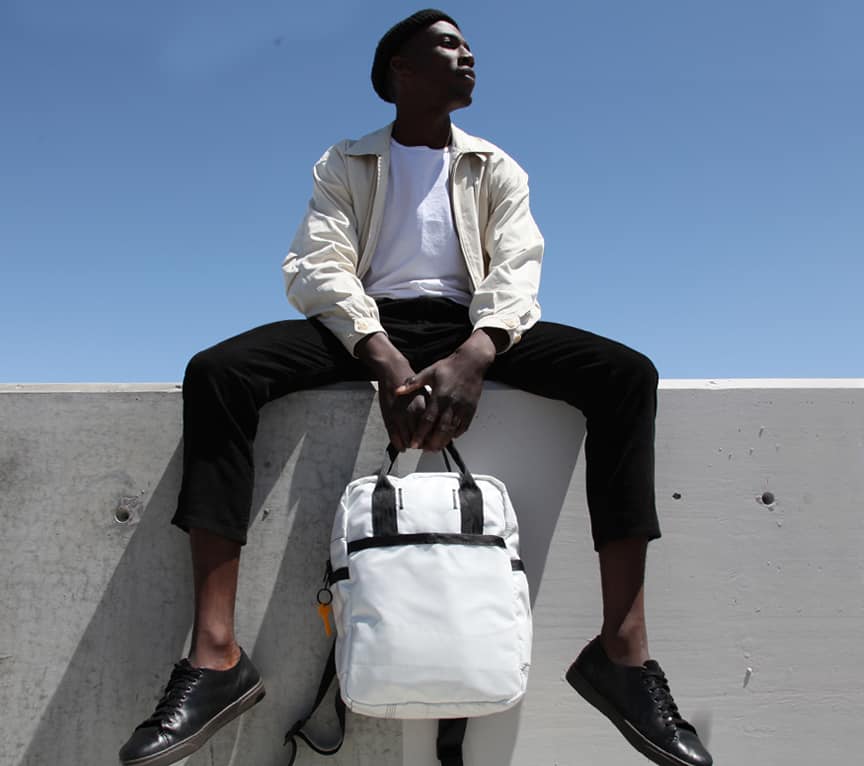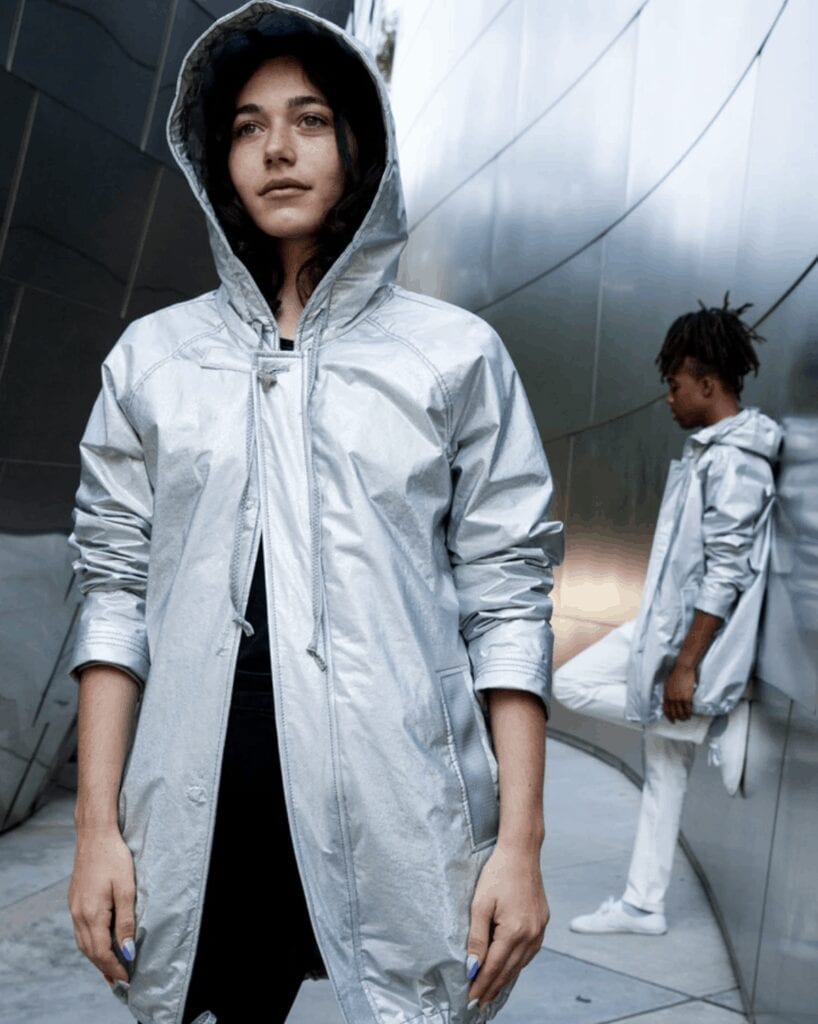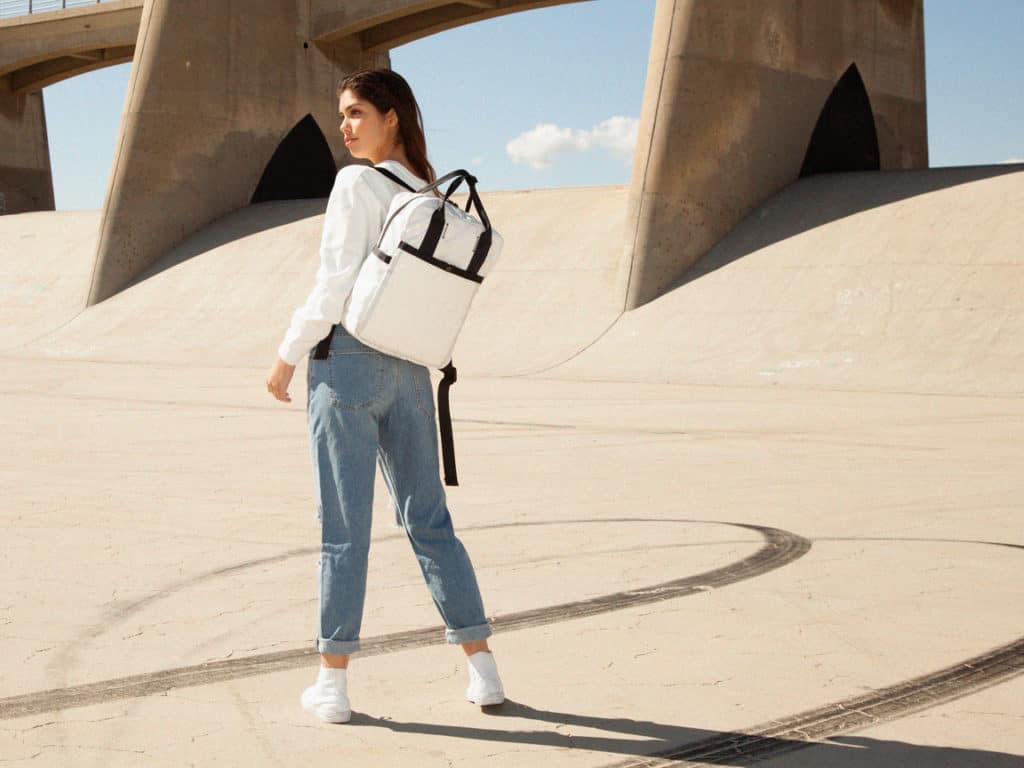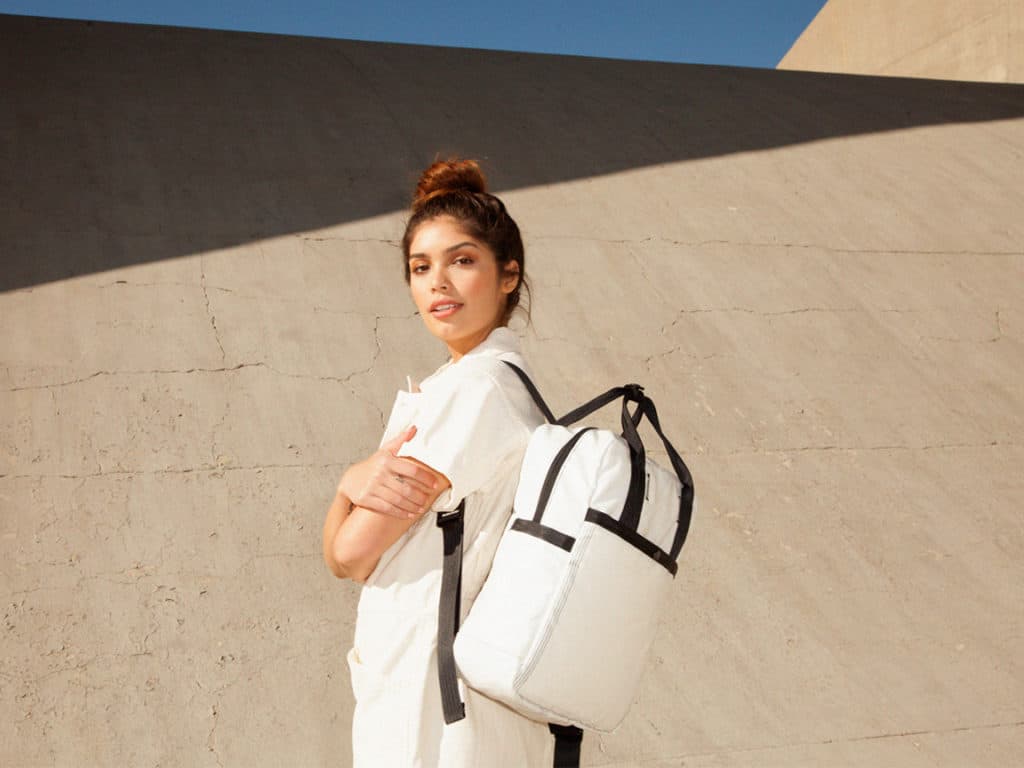Meet Rewilder, a sustainable fashion brand that finds beauty in discarded industrial materials, upcycling them into classic products that highlight their strength and durability. The brand is women owned, and manufacture ethically in Los Angeles.
The mission was to design a product that was completely zero waste, giving the founders the challenge of not using ANY material that wasn’t previously trashed. Adhering to this rule was a technical challenge that took three months to design and prototype. Every bit is salvaged: body, lining, thread, cords, and all hardware elements! Rewilder flipped the design process, letting the materials dictate the design, rather than designing first and finding materials to fit.

Below is an interview with Jenny Silbert, founder of Rewilder on her mission to become one of the most sustainable brands in the world.
How did you discover zero waste fashion, what inspired you to start Rewilder?
I have always been drawn to creative reuse – scavenging, dumpster diving, rebuilding and transforming things for as long as I can remember. I have always used what I find around me to solve problems. Rewilder is the perfect confluence of things that I care about – high design + creative reuse – and felt like a perfect natural extension of my architectural work into product design using repurposed materials.
My professional background is in Architecture and Materials R+D. I came across the beer filter cloth while teaching a Materials Innovation class at Art Center School of Design in Pasadena. In my research, I discovered the massive scale at which it was thrown away, and was inspired to start Rewilder and a new category of eco-fashion, where good design meets true sustainability.
How would you define and explain zero waste design?
At Rewilder, design and sustainability go hand-in-hand. It’s useless to make something simply because it’s sustainable; we need good design that exudes both form and function. It is both the responsibility of designers to prioritize sustainability, and consumers to choose sustainable alternatives. In tandem we can shift the way we see trash, disposables, and fast fashion. The future of design and manufacturing is zero waste.

In terms of environmental impact, upcycling is better than recycling. There are tons of materials that cannot be recycled, or simply will not be recycled. The unfortunate truth is that it’s more costly to rehabilitate waste resources than it is to landfill and buy new. Only 9% of the world’s plastic has ever been recycled. The automobile industry alone trashes 100,000 tons (the weight of 250 airplanes!) of non-recyclable material each year.
Downcycling should be a last resort, because it renders recycled material to a lower quality and functionality than the original material. Upcycling is creative reuse, an opportunity for imaginative solutions that add value to discarded materials, rather than take away. This is the future – sustainable creation and consumption, using resources already in existence. Design then becomes a tool for innovation that pushes zero waste fashion forward. The future depends on it.
Can you talk a little bit about the process of using trash to create beautiful backpacks and jackets?
At Rewilder, we flip the design process: designing from the perspective of the trash materials found, rather than sourcing new materials to fit a preconceived design. The materials dictate the designs, driving the styles we make and the final detailing.
We are constantly pushing to get better, and work toward truly zero waste design. With our new rain jacket, we set out to design a product that was completely zero waste, giving ourselves the challenge of not using ANY material that wasn’t previously trashed. The result is a 100% upcycled zero waste rain jacket, made from only high-performance industrial discard materials. From the shell, down to the trim, thread, and hardware, every component of the jacket is salvaged and given a new life.

The jacket’s silver fabric was originally used by the shipping industry as a cover that protected vehicles on a single journey across the Pacific. Designed to withstand the elements, it’s salt-waterproof, UV-protected, and reflective to shield from both salt and sun. These incredible protective properties lead to a major downside: the material will never decompose in a landfill and is impossible to recycle.
In addition to the shell, all of the jacket materials were meticulously sourced and diverted from landfill. The pocket trim details are salvaged grey seat belts; the inner fabric is a warp knit originally hidden as automotive linings; rope cords are stretched and stitched fabric; uncut keys make the top button; magnets as the main closures; and all the thread is from a large factory that discards ¼ spools at shift changes to keep work flow at maximum efficiency.
The upcycled materials that we found really drove the design, which started as a duffel. Deep in material development and hardware research, it became clear that due to component and design limitations, a duffel would not be feasible. In prototyping, the design evolved into a backpack, which ultimately morphed into a jacket based on the material properties and available salvaged hardware.
For all the beer lover fans out there, can you talk a little bit about the Beer Filter Cloth that Rewilder uses?
This beautiful trashed material was the inspiration for Rewilder and we started the company around this one material. It’s perfect for upcycling, with strength, durability, lightness, and a unique beauty. It’s also trashed on a massive scale and is almost impossible to recycle.
Beer Filter Cloth is polypropylene, a tight weave of plastic and nylon that’s used to filter hops and barley during the beer making process. One single large brewery typically trashes two tons of the material every 3 days. We get large bundles of material that we sort on a gradient from lightest coppery tones to a deep patina of dark grey. We call this Beer Brindle – the cloth has been dyed naturally by hops and barley during first life manufacturing.
So far, we have diverted over 4,500 pounds of this amazing material from the landfill (plus over 14,500 feet of climbing rope that we use as the bag handles!).

The Airbag Backpack is such an amazing idea. Can you talk about that product and the auto industry’s waste?
The Airbag Backpack is crafted from durable, high-performance airbag fabric and seatbelts; designed to save lives, but destined to live in a landfill for 500+ years. We salvage and upcycle this industrial trash into something you can treasure forever, saving 265 lbs. of CO₂ in the process. That’s equal to planting 6 trees, biking 300 miles vs. driving, or forgoing meat for 42 days.
In 2014, The Takata corporation recalled 56 million defective air bags, the largest automotive recall in U.S. history. It was this news story that started our research into airbags, and ultimately led to the design and production of the airbag backpack. For the backpack, we use pre-consumer factory discard material.
An airbag is a protective shell, built to be indestructible. Airbag material is high performance, lightweight, durable, waterproof, and surprisingly so beautiful. It has its own modern performance aesthetic and a unique textured graphic line pattern from its first life. Each backpack is unique because of this.

Over the next 5 years what do you want Rewilder to accomplish?
Our goal is to divert as much material from landfill as possible, continuing to lead the way toward a culture where we use and re-use materials that are already here, rather than making new. We believe that business has a unique opportunity to lead in environmental issues and shine light on the huge waste in all industry.
We are pushing the envelope, getting as close to 100% upcycled as possible with as small as footprint as possible, proving that it is both possible and profitable. Our ultimate goal is to create a business that will challenge, inspire and change the entire industry.
“Sustainability has become a buzzword. Bamboo products, reusable plastic bottles, organic cotton totes are all labeled and sold to the consumer as sustainable. What none of those things provide is an answer to our trash problem. We’ve created, and thrown away, so much more material than we could possibly bury. Rewilder sets out to disrupt the waste stream of corporations, and the creation of this 100% zero waste jacket is proof and promise that we can do better.”
– Stephanie Choi, Rewilder







